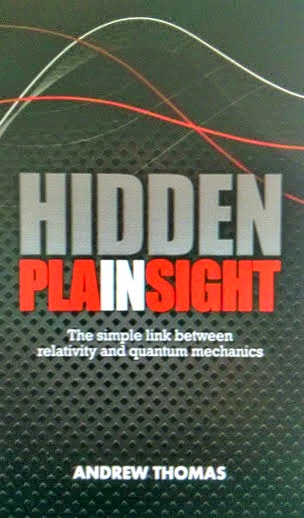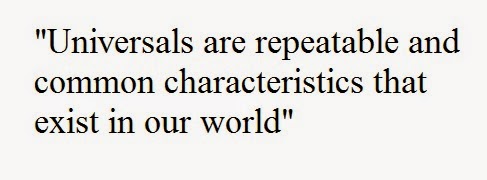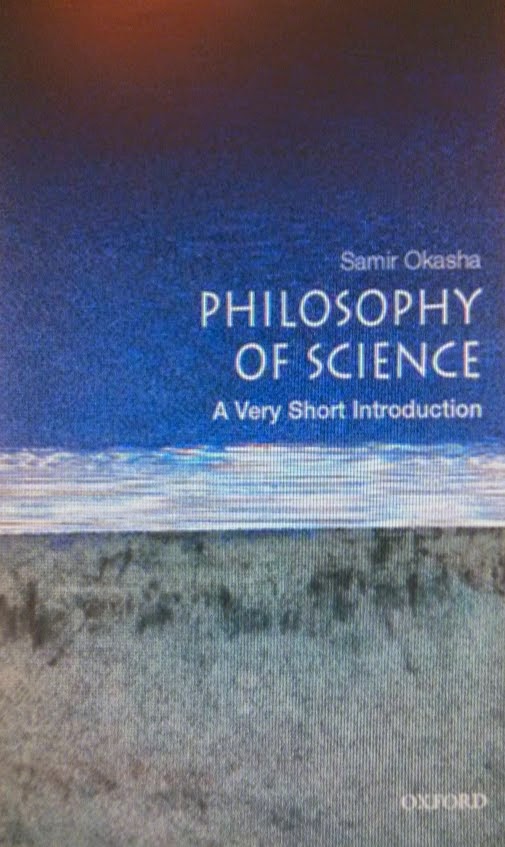"The way we see things is affected by what we know or what we believe"- John Berger. The book is one of the greats for understanding art and how perception makes all the difference in our lives. In any painting there are the perceptions of the painter and the perceptions of the audience. Each person sees something a little different from the painting based upon how they perceive the world around them. The concepts in his book have broader implications.
We know this through this experience but his book helps highlight this for the artistic crowd. Most of us have experienced two people seeing the same thing but interpreting what they are seeing differently. This can lead to all types of arguments and discussions on whose interpretation of the version is real.
To us our perceptions are real. What we see is real and what we feel is real. Despite this belief it is not necessarily true. Most of us have a single way of seeing the world and simply can't comprehend the ways others view the world. Entire cultures are in the delusion of their perception which leads to conflict.
In the book he looks at a number of different paintings and shows how the artists perception is built within the painting. Each painting has a hint to the nature of the author much like each of our actions gives a hint to us. Paying close attention to the objects, styles and colors in the painting will help you see a glimpse of who the author really is and how he/she views the world.
This is why we must sometimes close our eyes and see the world beyond the obvious. Take a look at the pieces, parts, and manners of a people and you will start to see how they view the world. Berger's specifically uses the concept that "men act-women appear". Men seek to gain and possess and women simply exist in relation to themselves. One is projecting outward and the other projecting inward.
The book has implications beyond art and sexual relations. The gazes he talks about can also be seen as the way we engage in selective attention. We see what we want to see in the world around us. We have been programmed in our lives to pay attention to certain cues from our environment and we are blind to the other cues and interpretations of the world. The scariest part of human nature is that we often misinterpret and try and force that misinterpretation on others.
The blog discusses current affairs and development of national economic and social health through unique idea generation. Consider the blog a type of thought experiment where ideas are generated to be pondered but should never be considered definitive as a final conclusion. It is just a pathway to understanding and one may equally reject as accept ideas as theoretical dribble. New perspectives, new opportunities, for a new generation. “The price of freedom is eternal vigilance.”—Thomas Jefferson
Showing posts with label book review. Show all posts
Showing posts with label book review. Show all posts
Saturday, February 28, 2015
Wednesday, September 24, 2014
Book Review: Hidden in Plain Sight Offers Easy to Understand Physics
Physics isn’t the most popular book topic people
gravitate towards when looking for a subject worthy of reading. Hidden in Plain
Sight by Andrew Thomas provides a broad overview of modern physics. Even though
the topics can be quite complex to lay readers this book has simplified the
principles so that seemingly complex topics are covered parsimoniously.
Two theories have dominated physics for more than a
century. General relativity and quantum mechanics have allowed scientists to
explore the universe with satellites and has led to new momentum in the space
race. The two theories have not been well connected in literature.
General relativity explains how objects
relate to each other in space as well as the influence of gravitational forces on the movement of those objects.
Quantum mechanics helped scientists develop the laser, computers, and other high
processing products. It is possible to argue that general relativity is about
big things while quantum mechanics looks at little things.
Quantum mechanics tells us how particles behave and
how they influence each other on a miniscule scale. The problem is that in physics
all particles and objects are relatively the same and should be following similar
rules. Whether one is looking through a microscope or a telescope the same
principles should be at work based upon the type of elements involved.
In Quantum mechanics everything in the universe is
connected to everything else. They may seem like they are separate but that is
not the case. Two particles may work together in unison in a system that
develops its own unique attributes. Some objects may have distance between the elements but can
still influence each other in a more complex arrangement.
Thomas, A. (2012) Hidden in Plain Sight: The simple link between relativity and quantum mechanics. [Kindle Edition].
Wednesday, September 10, 2014
Book Review: Philosophy 101 by Paul Kleinman
Philosophy 101 provides a broad snap shot of the
major philosophical thoughts since ancient times. The book is easy to read and simplifies
the theories and ideas for layman philosophers to see the depth and scope of
thought in human society. It is this human thought that has pushed society to
newer levels of thinking that keep humanity moving forward to new heights.
Philosophy is considered a cultured persons hobby, a
poor man’s occupation, and trivia entertainment to the masses. We fail to see
that philosophy is the root foundation of science and the two cannot be unmarried.
Skilled philosophers use multiple avenues to understand a problem and regularly
are running against the grain of current thought.
Despite the natural desire to arrest new thoughts in
society it is the philosophers that society owes its greatest consideration.
Whether we are discussing scientific principle or the very constitution of the
country none of it would have been possible unless philosophical minds pondered
the possibilities.
I selected one theory, one philosophical point, and a logical-sequential
function to highlight the point. The Theory of Universals tells us that
everything in the universe has some type of order through connecting
universals, the Philosophy of Cultures shows us that understanding our world is
subjective based upon rearing, and the Scientific Method guides us in a
methodology of testing our environment.
The Theory of Universals:
The Theory of Universals states that there are
universals in our world outside of mind and language. Plato believed that there
were properties and qualities that can characterize our world. Some believe in
forms that exist outside space and time while others believe they exist within
our space and time. The example provided are the redness of a cherry and apple
and how these exist regardless of whether or not someone perceives them.
If we were to look at science and properties we can
find that there are universals in terms of elements that exist and function
regardless of whether or not we perceive them. As technology increases we are
able to perceive universals in their more minute form and change how we define
them in our minds but don’t necessary change the fundamental nature of
existence. It exists whether or not we are aware of it.
The Philosophy of Culture:
Culture in the past was seen differently than it is
today. Culture was part of the rearing process and created a way of
understanding the world. It fundamentally changed how we view the world and how
we see particular issues. Culture is embedded in our language and mental images
derived from language.
Culture is seen as collective or individualistic. In
collective societies people see their duties to their social networks while in
individualistic societies people feel that their duties lie primarily with
themselves. Ethics and values can be culturally relative depending on the
values one is reared with. Some have argued that both types of cultural vantage
points can still judge right and wrong based upon helpful and unhelpful
behaviors.
The Enlightenment:
 The enlightenment changes the way in which we view
the world as philosophers sought to find truth in the universe. It had a
profound impact on perceptions of society, government, nature, the universe,
and rational thought. It changed the mystical views of the past to the
scientific method we use today.
The enlightenment changes the way in which we view
the world as philosophers sought to find truth in the universe. It had a
profound impact on perceptions of society, government, nature, the universe,
and rational thought. It changed the mystical views of the past to the
scientific method we use today.
The scientific method provided a frame work for
reason and logic to analyze the world around us. The circular model is based on
observation, theory development, prediction, and experimentation. As new
observations and predictions occur new theories develop and existing ones are
adjusted to make them more accurate.
Kleinman, P. (2013) Philosophy 101. [Kindle DX version]. Retrieved from Amazon.com
Monday, July 21, 2014
Book Review: The Philosophy of Science A Very Short Introduction
The Philosophy of Science A Very Short Introduction by
Samir Okasha discusses the very nature of science and what it means to engage
in scientific thinking. The book will bring you through the definitions of
science, scientific reasoning, realism and anti-realism, scientific revolutions
and philosophical problems. It is solid reading for students and laypeople that
desire to get a basic grasp of science.
Science started in the 1400 to 1700 with people like
Copernicus who built a model of the universe and Aristotle who put forward ideas
of physics, biology, astronomy and cosmology. Science is a way in which we
think about the world (i.e. scientific mindset) and how we compare and contrast
elements to come to conclusions of the world in which we live.
A key component of science is a concept called
falsifiable brought forward by Karl Popper. All theories and predictions must
be falsifiable in the sense that experience can determine them wrong over time.
Pseudo-science was described as theories of psychotherapy brought forward by Freud
because anything the patient does can be explained away with no obvious
observable proofs of latent functions.
Consider the use of a theoretical model to predict
that a certain event will occur. As time moves forward the event either happens
or it doesn’t thereby making is verifiable. Theories that cannot be tested and
shown to be false are also unlikely to be true. There must be criteria to lend
support or take support away from the theory. If you can’t prove or disprove it
then it isn’t a theory.
More pointedly the book discusses induction and
deduction as methods of understanding concepts and coming to new conclusions.
The example of deduction provided by the book is 1.) The French like wine, and
2.) Pierre is a Frenchman therefore it can be deducted that Pierre likes wine. It doesn’t matter if the inferences actually
make the conclusion true but that they can lead to the conclusion.
Inductive reasoning is difficult to use in science
but is commonly applied to everyday life. It is assumed that the sun rises in the East and
sets in the West every day. Using inductive reasoning we can say that the sun
will rise in the East tomorrow and set in the West. We are likely to be right
but that doesn’t make it a truth while the observation isn’t necessarily proof
that it will happen over and over.
The book doesn’t move into this concept but it is
possible to use deductive, inductive and probable abductive reasoning together
to be more accurate. We may use deductive reasoning to go from the general down
to the specific and then use inductive reasoning to rebuild the model outward
in another place to see if it also holds true. We can then use abductive reasoning to
understand the likelihood of the conclusion holding true to the explanation in
both examples.
Either way you are likely to find the book
interesting and provide a broad understanding of the basic principles of
science. It is the type of book you should read if you have studied the sciences,
plan on studying to a doctorate, or want to test something within your
environment. The price on kindle is reasonable and retails for around $2.
Tuesday, July 15, 2014
Book Review: The Moral Tale of Moby Dick
Moby Dick by Herman Melville is a classical example
of 1851 literature that sparks deeper levels of thinking and provides a moral
story for readers. As an artistic production it is seen as one of the greatest
seafaring stories ever written. It provides a glimpse of early American life
through the occupational experiences of sailors.
Literature has an important function in society and
transfers values and cultural beliefs. Story telling has been part of the human
experience since the beginning of humanity. Moby Dick tells a moral story as
much as it tells the tale of a whale hunt. Encouraging people to read such stories
and think about their meanings helps to broaden their perspective.
Some of the lessons you may encounter include:
Don’t
Let Your Passions Consume You: Captain Ahab had a
mission and he was going to fulfill that mission at all costs. His passions
consumed him to the point that he no longer considered the other factors
associated with winning. All missions should use sound judgment
and reasons to balance out the decision-making process.
The
Whale Represents Greatness: At this time in society killing a white
whale represented wealth, prestige, and accomplishment. As one of the largest
creatures known to man it was difficult to find, harpoon, and bring to market.
Moby Dick came to represent man’s desire for material and social recognition.
A
Piece of American Experience: Melville used his experience
as a sailor to write the story and became a sensation. The story
represents how life was experienced by seafaring people in New England during the
19th Century. Life was
different then and economies made their money from natural resources such as
fishing, farming, mining and lumber.
Forms
of Government: The process of gathering sailors from
various walks of life is a democratic process where all members are individually
judged based on their contributing skills. In a capitalistic society each
member is focused on catching whales for economic purposes and has a positive contribution on collective action. Captain Ahab turns into the tyrant who fails to consult
with others which eventually leads his crew to death.
The
Flipping of Good and Evil: At the beginning of the story Moby
Dick is characterized as evil and must be hunted down for its savage behavior. As
the story unfolds you find that Moby Dick is only escaping the hunt and was
never a man eater. Eventually we find out that it is Captain Ahab that failed
to use sound reason and becomes the embodiment of evil in the story while he
irrationally hunts Moby Dick for his own vain egotism.
You don’t need to pay for this book. It is offered
for free on Kindle.
As an interesting side note whale attacks can still
happen. In July a crew of two people were attacked tracking whales on a picture
taking escapade. Following their target at 150 yards a second whale jumped upon
their ship capsizing both crew members and flipping the boat. The incident occurred
in the ocean somewhere off Point Loma in San Diego. You may want to watch a
little of their experiences to get a feeling for the chaos of a whale attack.
Fox News San Diego provides additional details (1).
Subscribe to:
Posts (Atom)



